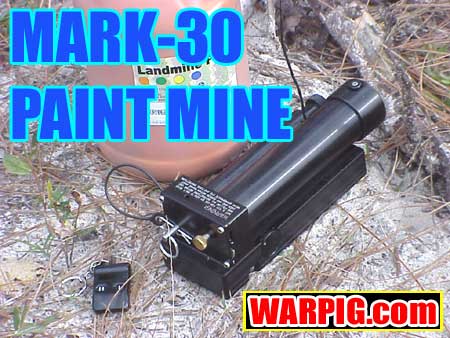  |
|
|
|
|
|
|
  |
|
|
|
|
|
|

What
do you think?
|

Mark 30 Paint Mine by Bill Mills December 2001 While many designers in paintball are focusing on paintguns, BlackPoint Engineering, a division of specially machine shop Jet City Specialties has developed the Mark 30 paint mine. Priced as much as a typical paintgun, the Mark 30 isn't for every player. For the serious scenario paintball player though, the Mark 30 is a very impressive product. In the simplest terms, the Mark 30 is a sprinkler that sprays liquid paint. It is powered by CO2 and either an electronic radio controlled triggering system, or a mechanical trigger.
A series of warnings are laser engraved on the bottom of the Mark 30, as well as a Federal Communications Commission compliance label (for the wireless remote version) which states that the unit is "for home or office use." A word of caution - if you fire off the Mark 30 in your office, you may be asked to look for a new job. A back plate stands up out of the rear of the Mark 30, with a pair of tubes running out of it, parallel to the base. A narrow tube is used for the CO2, while a larger tube is the paint reservoir and piston.
Loading begins with the paint. It takes three or four turns to remove the end cap from the paint reservoir. If the Mark 30 was recently fired, the piston disk must be reset to the far end of the paint reservoir. This is done by pulling on a steel reset rod out of the rear of the unit, rather like loading a grease gun. It is critical that the reset rod be locked when it is slid back into the paint reservoir.
Before loading the CO2 cartridge into place, the pierce pin must be secured to prevent a mis-fire. This steel pin extends out the back of the unit, and has a ring through it, so that it can be pulled back, cocking the mechanism. A clip pin goes through a hole in the pierce pin as a safety - this is very important. The clip pin is kept on a plastic leash to keep it conveniently close at hand.
Now the Mark 30 is ready to be placed. It should be put in an area of the field where the operator can see the target area, and the spray nozzle has an unobstructed path to spray the target area, but the unit itself it not on plain view. The Mark 30 could be placed on the ground near a trail intersection, up in a tree, or more deviously in the ceiling rafters of a fort or base (so long as it is not in a sealed building like a radio room where goggles might be removed).
The sear that holds the pierce pin back is quite sensitive. This is so that it can be tripped by the solenoid in the base. The slightest twist of the pierce pin, or even a good solid rap on the Mark 30 case is enough to set it off, showering the person setting it. For this reason it is as important to use paintball goggles/mask when setting the as when using it. Fortunately, the pierce pin isn't damaged from dry firing, and Blackpoint engineering recommends dry firing the Mark 30 many times to get the feel for setting the pierce pin. In practice simply dry firing a couple of times by twisting the firing pin is enough to get the feel for how to properly set it. With very little effort, one can learn to load and set the Mark 30 quickly and reliably.
The Mark 30 is
far from what one would consider a conventional paintball product.
While mines don't have a place in tournament play, they fit perfectly in
scenario games, and can be a fun addition for field owners catering to
group customers such as corporate and church groups, where mini-scenarios
and and extra surprise can be fun. The Mark 30 is very well built,
simple to operate and very effectively marks players within its range.
|
| Copyright © 1992-2019
Corinthian Media Services. WARPIG's webmasters can be reached through our feedback form. All articles and images are copyrighted and may not be redistributed without the written permission of their original creators and Corinthian Media Services. The WARPIG paintball page is a collection of information and pointers to sources from around the internet and other locations. As such, Corinthian Media Services makes no claims to the trustworthiness or reliability of said information. The information contained in, and referenced by WARPIG, should not be used as a substitute for safety information from trained professionals in the paintball industry. |